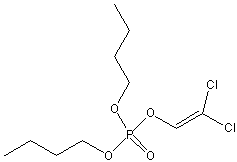Dibutyl-dichlorovinyl-phosphate~DBVP
potent organophosphorus neuropathy target esterase (NTE not alpha/beta hydrolase) inhibitor
General
Type : Organophosphate,NTE inhibitor,Not A\/B H target
Chemical_Nomenclature : 1-(butoxy-(2,2-dichloroethenoxy)phosphoryl)oxybutane
Canonical SMILES : CCCCOP(=O)(OCCCC)OC(=CCl)Cl
InChI : InChI=1S\/C10H19Cl2O4P\/c1-3-5-7-14-17(13,15-8-6-4-2)16-10(12)9-11\/h9H,3-8H2,1-2H3
InChIKey : ZRSXWECQLMXKHF-UHFFFAOYSA-N
Other name(s) : DBDCVP,DBVP,di-n-butyl dichlorvos,2,2-dichlorovinyldibutylphosphate,Dibutyl 2,2-dichlorovinyl phosphate,EINECS 242-584-1,BRN 1712889,Di-n-butyl-2,2-dichlorovinyl phosphate [MeSH: di-n-butyl-2,2-dichlorovinyl phosphate],AI3-20756,Phosphoric acid, dibutyl 2,2-dichlorovinyl ester,4-01-00-02064,Phosphoric acid, dibutyl 2,2-dichloroethenyl ester,18795-58-9
MW : 305.13
Formula : C10H19Cl2O4P
CAS_number :
PubChem : 54562823
UniChem : ZRSXWECQLMXKHF-UHFFFAOYSA-N
IUPHAR :
Wikipedia :

Target
Families : Dibutyl-dichlorovinyl-phosphate~DBVP ligand of proteins in family: Carb_B_Chordata
Stucture :
Protein :
References (9)
| Title : Effects of S-ethyl hexahydro-1H-azepine-1-carbothioate (molinate) on di-n-butyl dichlorovinyl phosphate (DBDCVP) neuropathy - Moretto_2001_Toxicol.Sci_62_274 |
| Author(s) : Moretto A , Gardiman G , Panfilo S , Colle MA , Lock EA , Lotti M |
| Ref : Toxicol Sci , 62 :274 , 2001 |
| Abstract : Moretto_2001_Toxicol.Sci_62_274 |
| ESTHER : Moretto_2001_Toxicol.Sci_62_274 |
| PubMedSearch : Moretto_2001_Toxicol.Sci_62_274 |
| PubMedID: 11452140 |
| Title : Brainstem axolemmal protein phosphorylation in vitro in hens dosed with di-1-butyl-2,2-dichlorovinyl phosphate - Huggins_1999_J.Toxicol.Environ.Health.A_56_263 |
| Author(s) : Huggins DJ , Richardson RJ |
| Ref : J Toxicol Environ Health A , 56 :263 , 1999 |
| Abstract : Huggins_1999_J.Toxicol.Environ.Health.A_56_263 |
| ESTHER : Huggins_1999_J.Toxicol.Environ.Health.A_56_263 |
| PubMedSearch : Huggins_1999_J.Toxicol.Environ.Health.A_56_263 |
| PubMedID: 10706244 |
| Title : Inhibition of carboxylesterases in SH-SY5Y human and NB41A3 mouse neuroblastoma cells by organophosphorus esters - Ehrich_1998_J.Toxicol.Environ.Health_53_385 |
| Author(s) : Ehrich M , Correll L |
| Ref : J Toxicol Environ Health , 53 :385 , 1998 |
| Abstract : Ehrich_1998_J.Toxicol.Environ.Health_53_385 |
| ESTHER : Ehrich_1998_J.Toxicol.Environ.Health_53_385 |
| PubMedSearch : Ehrich_1998_J.Toxicol.Environ.Health_53_385 |
| PubMedID: 9515941 |
| Title : Organophosphate polyneuropathy in chicks - Peraica_1993_Biochem.Pharmacol_45_131 |
| Author(s) : Peraica M , Capodicasa E , Moretto A , Lotti M |
| Ref : Biochemical Pharmacology , 45 :131 , 1993 |
| Abstract : Peraica_1993_Biochem.Pharmacol_45_131 |
| ESTHER : Peraica_1993_Biochem.Pharmacol_45_131 |
| PubMedSearch : Peraica_1993_Biochem.Pharmacol_45_131 |
| PubMedID: 8381002 |
| Title : Clinical expression of organophosphate-induced delayed polyneuropathy in rats [published erratum appears in Toxicol Lett 1992 Dec\;63(3):355] - Moretto_1992_Toxicol.Lett_63_97 |
| Author(s) : Moretto A , Capodicasa E , Lotti M |
| Ref : Toxicol Lett , 63 :97 , 1992 |
| Abstract : Moretto_1992_Toxicol.Lett_63_97 |
| ESTHER : Moretto_1992_Toxicol.Lett_63_97 |
| PubMedSearch : Moretto_1992_Toxicol.Lett_63_97 |
| PubMedID: 1412529 |
| Title : Age sensitivity to organophosphate-induced delayed polyneuropathy. Biochemical and toxicological studies in developing chicks - Moretto_1991_Biochem.Pharmacol_41_1497 |
| Author(s) : Moretto A , Capodicasa E , Peraica M , Lotti M |
| Ref : Biochemical Pharmacology , 41 :1497 , 1991 |
| Abstract : Moretto_1991_Biochem.Pharmacol_41_1497 |
| ESTHER : Moretto_1991_Biochem.Pharmacol_41_1497 |
| PubMedSearch : Moretto_1991_Biochem.Pharmacol_41_1497 |
| PubMedID: 2018554 |
| Title : In vivo and in vitro regional differential sensitivity of neuropathy target esterase to di-n-butyl-2,2-dichlorovinyl phosphate - Moretto_1989_Arch.Toxicol_63_469 |
| Author(s) : Moretto A , Lotti M , Spencer PS |
| Ref : Archives of Toxicology , 63 :469 , 1989 |
| Abstract : Moretto_1989_Arch.Toxicol_63_469 |
| ESTHER : Moretto_1989_Arch.Toxicol_63_469 |
| PubMedSearch : Moretto_1989_Arch.Toxicol_63_469 |
| PubMedID: 2619560 |
| Title : Time course of electrophysiologic effects induced by di-n-butyl-2,2-dichlorovinyl phosphate (DBCV) in the adult hen - Robertson_1988_J.Toxicol.Environ.Health_23_283 |
| Author(s) : Robertson DG , Mattson AM , Bestervelt LL , Richardson RJ , Anderson RJ |
| Ref : J Toxicol Environ Health , 23 :283 , 1988 |
| Abstract : Robertson_1988_J.Toxicol.Environ.Health_23_283 |
| ESTHER : Robertson_1988_J.Toxicol.Environ.Health_23_283 |
| PubMedSearch : Robertson_1988_J.Toxicol.Environ.Health_23_283 |
| PubMedID: 3351976 |
| Title : Progressive deficit of retrograde axonal transport is associated with the pathogenesis of di-n-butyl dichlorvos axonopathy - Moretto_1987_J.Neurochem_49_1515 |
| Author(s) : Moretto A , Lotti M , Sabri MI , Spencer PS |
| Ref : Journal of Neurochemistry , 49 :1515 , 1987 |
| Abstract : Moretto_1987_J.Neurochem_49_1515 |
| ESTHER : Moretto_1987_J.Neurochem_49_1515 |
| PubMedSearch : Moretto_1987_J.Neurochem_49_1515 |
| PubMedID: 2444671 |